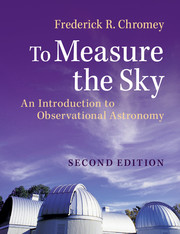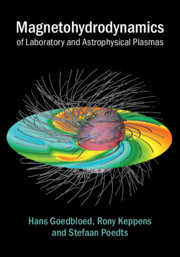Refine listing
Actions for selected content:
17002 results
Dedication
-
- Book:
- Stars and Stellar Processes
- Published online:
- 21 March 2019
- Print publication:
- 07 February 2019, pp v-vi
-
- Chapter
- Export citation
9 - The Formation of Stars
- from Part II - Stellar Evolution
-
- Book:
- Stars and Stellar Processes
- Published online:
- 21 March 2019
- Print publication:
- 07 February 2019, pp 201-227
-
- Chapter
- Export citation
Appendix C - Mean Molecular Weights
-
- Book:
- Stars and Stellar Processes
- Published online:
- 21 March 2019
- Print publication:
- 07 February 2019, pp 505-506
-
- Chapter
- Export citation
15 - Stellar Pulsations and Variability
- from Part II - Stellar Evolution
-
- Book:
- Stars and Stellar Processes
- Published online:
- 21 March 2019
- Print publication:
- 07 February 2019, pp 337-345
-
- Chapter
- Export citation
2 - The Hertzsprung–Russell Diagram
- from Part I - Stellar Structure
-
- Book:
- Stars and Stellar Processes
- Published online:
- 21 March 2019
- Print publication:
- 07 February 2019, pp 32-52
-
- Chapter
- Export citation
Index
-
- Book:
- Stars and Stellar Processes
- Published online:
- 21 March 2019
- Print publication:
- 07 February 2019, pp 534-546
-
- Chapter
- Export citation
Contents
-
- Book:
- Stars and Stellar Processes
- Published online:
- 21 March 2019
- Print publication:
- 07 February 2019, pp ix-xxii
-
- Chapter
- Export citation
Part III - Accretion, Mergers, and Explosions
-
- Book:
- Stars and Stellar Processes
- Published online:
- 21 March 2019
- Print publication:
- 07 February 2019, pp 399-400
-
- Chapter
- Export citation
References
-
- Book:
- Stars and Stellar Processes
- Published online:
- 21 March 2019
- Print publication:
- 07 February 2019, pp 524-533
-
- Chapter
- Export citation
Appendix D - Reaction Libraries
-
- Book:
- Stars and Stellar Processes
- Published online:
- 21 March 2019
- Print publication:
- 07 February 2019, pp 507-515
-
- Chapter
- Export citation
14 - Evolution of Higher-Mass Stars
- from Part II - Stellar Evolution
-
- Book:
- Stars and Stellar Processes
- Published online:
- 21 March 2019
- Print publication:
- 07 February 2019, pp 324-336
-
- Chapter
- Export citation
4 - Hydrostatic and Thermal Equilibrium
- from Part I - Stellar Structure
-
- Book:
- Stars and Stellar Processes
- Published online:
- 21 March 2019
- Print publication:
- 07 February 2019, pp 86-104
-
- Chapter
- Export citation
Frontmatter
-
- Book:
- Stars and Stellar Processes
- Published online:
- 21 March 2019
- Print publication:
- 07 February 2019, pp i-iv
-
- Chapter
- Export citation
16 - White Dwarfs and Neutron Stars
- from Part II - Stellar Evolution
-
- Book:
- Stars and Stellar Processes
- Published online:
- 21 March 2019
- Print publication:
- 07 February 2019, pp 346-377
-
- Chapter
- Export citation

To Measure the Sky
- An Introduction to Observational Astronomy
-
- Published online:
- 05 February 2019
- Print publication:
- 20 October 2016
-
- Textbook
- Export citation

Magnetohydrodynamics of Laboratory and Astrophysical Plasmas
-
- Published online:
- 01 February 2019
- Print publication:
- 31 January 2019
4 - The MHD model
- from Part II - Basic Magnetohydrodynamics
-
- Book:
- Magnetohydrodynamics of Laboratory and Astrophysical Plasmas
- Published online:
- 01 February 2019
- Print publication:
- 31 January 2019, pp 105-146
-
- Chapter
- Export citation
7 - Waves and instabilities of inhomogeneous plasmas
- from Part III - Standard Model Applications
-
- Book:
- Magnetohydrodynamics of Laboratory and Astrophysical Plasmas
- Published online:
- 01 February 2019
- Print publication:
- 31 January 2019, pp 233-291
-
- Chapter
- Export citation
Part I - Plasma Physics Preliminaries
-
- Book:
- Magnetohydrodynamics of Laboratory and Astrophysical Plasmas
- Published online:
- 01 February 2019
- Print publication:
- 31 January 2019, pp 1-2
-
- Chapter
- Export citation
20 - Computational nonlinear MHD
- from Part VI - Nonlinear Dynamics
-
- Book:
- Magnetohydrodynamics of Laboratory and Astrophysical Plasmas
- Published online:
- 01 February 2019
- Print publication:
- 31 January 2019, pp 780-836
-
- Chapter
- Export citation
